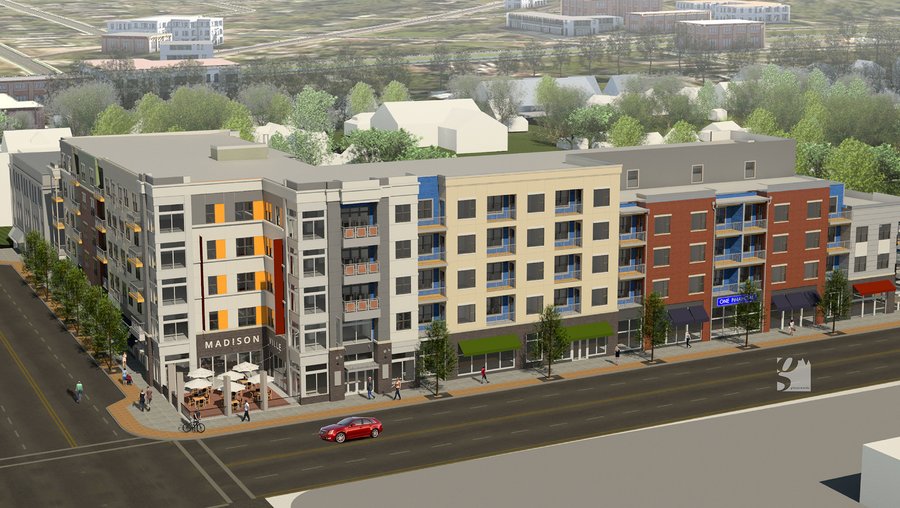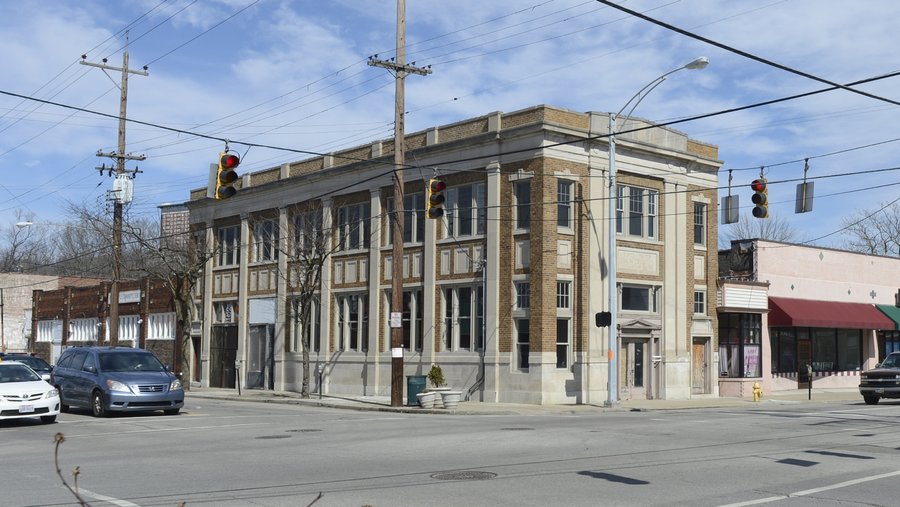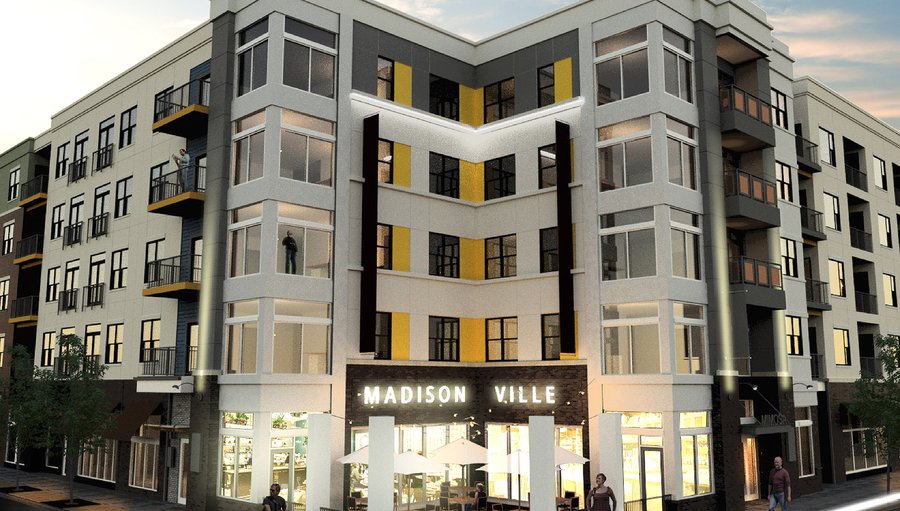Sara Sheets fell in love with Madisonville in the early 2000s.
Sheets and her husband, Jonathan Sinclair, were looking around Cincinnati for their first home and wanted to be part of a vibrant city neighborhood. They found an ideal home in 2003 on Hector Avenue, a beautiful, quiet street. But the neighborhood, which is surrounded by upscale Indian Hill, Mariemont and Oakley, was missing one thing: a bustling business district.
“Madisonville has always been a strong, stable neighborhood with great housing stock and welcoming residents,” said Sheets, who became executive director of Madisonville Community Urban Redevelopment Corp. (MCURC) in 2013.
“What’s been missing for several decades is a central gathering place for the neighborhoods, a vibrant commercial corridor.”
The redevelopment of Madisonville’s business district has been a decade in the making and now work is finally expected to start on a project that should kick-start it, which is at the intersection of Madison Road and Whetsel Avenue.
Real estate developer Ackermann Group plans to break ground on the first of three phases of development at the intersection of Madison Road and Whetsel Avenue this year. The first phase is expected to include a new mixed-use building with 24,000 square feet of commercial space topped by 104 apartments, renovations and upgrades for the existing Madisonville Retail Center at 5818 Madison Road and the historic Fifth Third Building that will be home to a brewery.

$30M investment in phase 1
In total, $30 million will be invested in the first of a planned three-phase development.
Dobbs Ackermann, CEO of Ackermann Group, said he sees his firm as a facilitator, finishing the acquisition of properties, listening to community desires and using its knowledge of the market to combine those pieces to create a development that is made for the next 100 years.
“Madisonville has all the elements in place for it to be a thriving and successful community,” Ackermann said. “The stimulus that was needed was the development of the four blocks (of Madison and Whetsel).”
In the 1950s, East Siders shopped at the two grocers, butcher and bakery in downtown Madisonville. The neighborhood also boasted a movie theater, sporting goods store and a well-known shoe store. Madison Road was the retail hub for half the city. Its population in 1960 was 17,447 compared to 9,141 in 2010.
But with the development of Kenwood Towne Centre and other retail areas, Madisonville fell into decline in the 1970s. Surrounded by wealthier communities, the neighborhood became a place to drive through, not go to.
The redevelopment of Madisonville’s heart is expected to bring hundreds of new residents, increase property values, create new jobs and businesses and continue to strengthen the economic comeback of the city. The hope is that the work here will connect to other developments in the neighborhood, such as the $115 million Medpace campus expansion and the $25 million RED apartment development, to create another vibrant part of the region.
It’s been a long time coming for Madisonville’s business district. The city of Cincinnati quietly started buying property in the area in 2008. That year, Madisonville’s business district was also named a target area for redevelopment opportunities in the Go Cincinnati report. Demolition of dilapidated buildings also started in 2008.
In 2012, Madisonville completed a quality-of-life plan. Nearly 200 residents and leaders of neighborhood organizations and businesses developed the plan, which includes six priority areas of economic development: health and wellness, the built environment, community engagement, arts and culture, education and youth. The plan also included strategies to reach those goals.
By 2014, the city of Cincinnati had acquired about 7 acres at the Madison and Whetsel intersection and sent out a request for qualifications to the development community. Ackermann Group was selected as master developer.
For the past three years, Ackermann Group has been working on the project. Financing the project has been the most challenging hurdle. In 2017, the Madison & Whetsel project was awarded $18 million in New Markets Tax Credits. Ackermann Group expects to close on its purchase of the property in the next few weeks and start construction in September. The project is expected to be delivered in the first quarter of 2020.

Just the potential of this project has helped speed up redevelopment in Madisonville. Average home sale prices in Southwest Ohio climbed 22.5 percent from 2013 to 2017. Last year, the average sale price was $207,169, up from an average sale price of $165,037 five years ago.
But Madisonville home prices have eclipsed that pace. The average home sale price in Madisonville in 2013 was $65,736, according to data from MLS of Greater Cincinnati. Last year, the average sale price jumped to more than $117,000, an increase of more than 78 percent. Madisonville’s home sale prices have continued to climb this year.
Homebuilders are buying vacant lots and constructing new homes priced as high as the $300,000s. Renovated three-bedroom, two-bathroom homes are selling for more than $250,000.
Residents’ input
When the Madisonville opportunity arose, Ackermann had just come off the development of University Station near Xavier University. Ackermann said they were attracted to this project because they believed in MCURC, the community council and the support Mayor John Cranley has put behind the project.
It helps that the residents of Madisonville went through the form-based code and quality-of-life planning. When it came time to craft a Request for Quotation, Madisonville had a clear picture of what it wanted.
“They did all the groundwork, they defined who they are and where they are going,” Ackermann said.
Downtown-based Glaserworks is the project’s architect and Al Neyer is construction manager. The $18 million in New Markets Tax Credits comes from a mix of organizations, including the Cincinnati Development Fund, Chase Bank and others. First Financial Bank also is providing traditional financing on the project. A $1 million federal grant will help pay for the expansion of the Braxton Health Center.
Cincinnati City Council approved a $2 million grant for streetscape improvements, the funding of which will come from a tax-increment financing district. It also approved the sale of city property for $1, a $2.2 million allowance for other public improvements from the tax-increment financing district and $750,000 from the city’s capital budget for acquisition and demolition costs.
The streetscape improvements are meant to slow traffic in the area and help create a sense of place, said Chris Breda, director of development for Ackermann Group. For the retail space, Ackermann is looking to bring two neighborhood-oriented restaurants. As for the commercial space, Ackermann Group will be relocating its headquarters and about 20 of its 85 employees from Norwood to about 8,000 square feet of space. They also plan to create a 5,000-square-foot coworking space.
Jeff Raser, principal with Glaserworks, said this project has taken a lot of feedback from the community and made it part of the development.
“The community cares,” Raser said. “They are willing to meet and express opinions before things happen.”
Sheets said the vision the neighborhood wanted to ensure is that this project would be a mixed-income, mixed-use project. The community is dedicated to maintaining its economic and racial diversity. Twenty percent of the apartments will be affordable to people who make 80 percent of the area median income.
“We’re trying really hard to make sure there is a space for everybody,” Sheets said.
It takes time to have those community meetings and get feedback from residents, but Ackermann said it is necessary on a project like this one.
“We’re patient about how we go through the process,” Ackermann said. “That’s why it’s taken three years.”

Raser sees this first phase as the spark that will fan the flames of redevelopment in the neighborhood.
“This building, this corner, is just the beginning,” Raser said. “We’re going to rebuild Madisonville’s downtown. We’re just getting started.”
Those additional phases, which are expected to include a mix of housing and commercial space, are expected to start in the next two to three years. It’s expected to add at least 100 to 150 more apartments, as well as more retail, entertainment and office space.
Sheets, who has raised two children in Madisonville walking to parks and a business district, said starting work on Madison and Whetsel will fill a missing piece.
“This will give people the opportunity to socialize and spend money in our neighborhood, to take a guest when they come to visit,” Sheets said.
